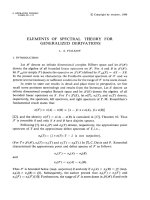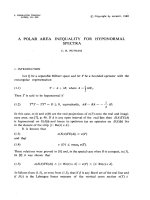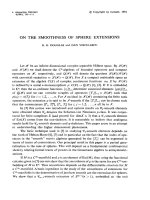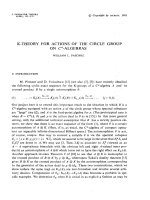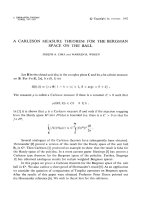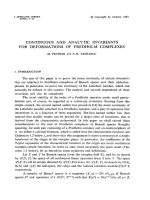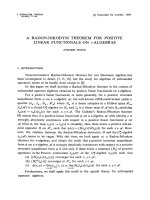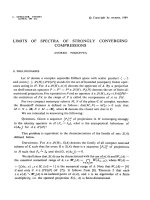Báo cáo toán học: "Short Score Certificates for Upset Tournaments." potx
Bạn đang xem bản rút gọn của tài liệu. Xem và tải ngay bản đầy đủ của tài liệu tại đây (143.17 KB, 18 trang )
Short Score Certificates for Upset Tournaments
Jeffrey L. Poet and Bryan L. Shader
Department of Mathematics
University of Wyoming
Laramie, Wyoming 82071,
,
Submitted: January 15, 1998; Accepted: May 5, 1998.
Abstract
A score certificate for a tournament, T , is a collection of arcs of T
which can be uniquely completed to a tournament with the same score-
list as T ’s, and the score certificate number of T is the least number of
arcs in a score certificate of T . Upper bounds on the score certificate
number of upset tournaments are derived. The upset tournaments on
n vertices are in one–to–one correspondence with the ordered parti-
tions of n−3, and are “almost” transitive tournaments. For each upset
tournament on n vertices a general construction of a score certificate
with at most 2n − 3 arcs is given. Also, for the upset tournament, T
λ
,
corresponding to the ordered partition λ, a score certificate with at
most n +2k+ 3 arcs is constructed, where k is the number of parts of
λ of size at least 2. Lower bounds on the score certificate number of
T
λ
in the case that each part is sufficiently large are derived. In par-
ticular, the score certificate number of the so-called nearly transitive
tournament on n vertices is shown to be n +3,forn≥10.
1 Introduction
Some recent research has been concerned with the problem of efficiently con-
veying the information contained in a binary relation [AR, KTF, R]. In this
paper we continue this line of research by studying the problem for a specific
the electronic journal of combinatorics 5 (1998), #R24 2
class of binary relations. Throughout we use the graph-theoretic notation
and terminology in [CL].
Let V = {v
1
,v
2
, ,v
n
}.Atournament, T,onV is a directed graph ob-
tained by replacing each edge of the complete graph on V with a directed arc.
Thus, a tournament represents a complete, asymmetric, irreflexive binary re-
lation. Throughout we use the notation and terminology for tournaments
in [M]. We denote the arc from vertex v
i
to vertex v
j
by the ordered pair
(v
i
,v
j
). The score of a vertex v
j
∈ V is its outdegree. The score-list of T is
the multiset of outdegrees of the vertices of T .
In this paper we are concerned with efficiently conveying the information
contained in a tournament. More precisely, a score certificate for T is a
subset, D, of arcs such that T is the unique tournament on V that contains
each arc in D and whose score-list is the same as T ’s. In other words, a score
certificate for T is a collection, D, of arcs with the property that T can be
unambiguously determined by knowing the arcs of D and the score-list of
T .Thescore certificate number of T is the least number of arcs in a score
certificate for T , and is denoted by sc(T ).
Score certificates were first studied in [FKT, KTF], where it is proven
that if T is not a regular tournament on 3 or 5 vertices, then
n − 1 ≤ sc(T ). (1)
Thus, to convey the results of a tournament on n vertices (via score certifi-
cates) at least n − 1 arcs are required in all but the two exceptional cases.
Note that the score certificate number of the transitive tournament on n ver-
tices is n − 1. In [AR], it is shown that there exists an >0 independent of
n such that
sc(T ) ≤ (1/2 − )n
2
(2)
for all tournaments T of order n. Also, in [AR] it is noted that there exist
tournaments on n vertices with score certificates at least (7/24 + o(1))n
2
.In
[FKT] it is shown that
n − 1 ≤ sc(N
n
) ≤ 3n − 9,
where N
n
is the tournament with vertices {v
1
,v
2
, ,v
n
}, and arcs (v
1
,v
n
)
and (v
i
,v
j
) for all other {v
i
,v
j
}with i>j. The tournament N
n
is called the
nearly transitive tournament on n vertices. Other than these results, little is
known about the score certificate number.
the electronic journal of combinatorics 5 (1998), #R24 3
In this paper, we study the score certificate number for a special family
of tournaments which generalize the nearly transitive tournament. An upset
tournament on n ≥ 4 vertices is a tournament whose score-list is
{1, 1, 2, 3, ,n−4,n−3,n−2,n−2}.
Properties of upset tournaments have been studied in [BL].
In Section 2, we show that
sc(T ) ≤ 2n − 3(3)
for each upset tournament T on n vertices. The upset tournaments on n
vertices possess special structural properties. In particular, they each have
a unique hamiltonian cycle and they are in one–to–one correspondence with
the ordered partitions of n − 3. In Section 2, we also give an upper bound
on the score certificate number of an upset tournament which is in terms
of the corresponding ordered partition. In most cases, this bound improves
that of (3). In Section 3, we derive lower bounds for a special family of upset
tournaments. As a consequence we show that the score certificate number of
the nearly transitive tournament on n vertices equals n +3,forn≥10.
We conclude this introductory section with necessary preliminaries con-
cerning upset tournaments. Clearly, a transitive tournament is not strongly
connected and has no 3-cycles. It follows from results in [M] that each up-
set tournament on n vertices has exactly n − 2 3-cycles, and this is the least
among strongly connected tournaments on n vertices. Thus, one can view the
upset tournaments as a class of strongly connected tournaments that are “al-
most” transitive. Since equality holds in (1) for the transitive tournaments,
it is natural to examine the score certificate number of upset tournaments.
It follows from the results in [BL] that the upset tournaments have a
special structure, which we now describe. An ordered partition of the positive
integer is a tuple of positive integers whose sum is . An ordered partition
λ =(p
1
,p
2
, ,p
k
)ofn−3 determines a tournament T
λ
on n vertices as
follows. Let V = {v
1
, ,v
n
} and let v
i
and v
j
be vertices with i<j.If
(v
i
,v
j
)is(v
1
,v
2
), (v
n−1
,v
n
)oroneof
(v
2
,v
2+p
1
), (v
2+p
1
,v
2+p
1
+p
2
), ,(v
2+p
1
+···+p
k−1
,v
2+p
1
+···+p
k−1
+p
k
),
then (v
i
,v
j
)isanarcofT
λ
.Otherwise,(v
j
,v
i
)isanarcofT
λ
. It is easy
to verify that T
λ
is an upset tournament. For example, the nearly transitive
the electronic journal of combinatorics 5 (1998), #R24 4
tournament on n vertices is isomorphic to T
(n−3)
. It follows from results in
[BL] that the nonisomorphic upset tournaments of order n are precisely the
T
λ
where λ runs over all ordered partitions of n−3. Hence, there are exactly
2
n−4
non-isomorphic upset tournaments of order n.
An arc (v
i
,v
j
) of a tournament T is an upset arc provided the score of
v
i
is less than or equal to that of v
j
. The upset arcs of T
λ
are precisely
the arcs (v
1
,v
2
), (v
n−1
,v
n
), and (v
2+p
1
+p
2
+···+p
j
,v
2+p
1
+p
2
+···+p
j
+p
j+1
)forj=
0,1,2, ,k−1. Note that upset arcs of an upset tournament form a path,
which we call its upset path.
An upset tournament T with vertices v
1
, ,v
n
is in standard form pro-
vided (v
i
,v
j
)withi<jis an arc of T if and only if (v
i
,v
j
)isinT’s upset
path. Thus, each T
λ
is in standard form, and each upset tournament can be
put into standard form by relabelling its vertices.
Pictorially, each upset tournament, T , in standard form can be con-
structed by placing the vertices v
1
,v
2
, ,v
n
in order from bottom to top
on a vertical line, drawing an path from v
1
to v
n
that goes through v
2
and
v
n−1
and consists entirely of upward-oriented arcs, and orienting all other
arcs downward. Moreover, up to isomorphism, the upset tournaments are
precisely the tournaments which have this type of picture. For example, the
upset tournaments with 6 vertices (in standard form) are given in Figure
1. Here, as is customary when illustrating tournaments, only the upward-
oriented arcs are shown.
λ
1
=(3)
v
1
v
2
v
3
v
4
v
5
v
6
λ
2
=(2,1)
v
1
v
2
v
3
v
4
v
5
v
6
λ
3
=(1,2)
v
1
v
2
v
3
v
4
v
5
v
6
λ
4
=(1,1,1)
v
1
v
2
v
3
v
4
v
5
v
6
Figure 1
the electronic journal of combinatorics 5 (1998), #R24 5
2 Upper bounds
In this section we derive two linear upper bounds on the score certificate
number of an arbitrary upset tournament on n vertices. The first does not
depend upon the partition corresponding to the tournament, but the second
does. We begin by describing certain arcs that are contained in each score
certificate of an upset tournament.
Let T be an upset tournament of order n. We define a forced arc of T to
be an arc (v
i
,v
j
)ofT wherethescoreofv
i
is 1 more than the score of v
j
.If
(v
i
,v
j
) is a forced arc, then the tournament obtained from T by reversing this
arc is also an upset tournament. Thus, every score certificate of T contains
each forced arc of T .
It is easy to determine the forced arcs of the upset tournament T
λ
cor-
responding to the ordered partition λ =(p
1
,p
2
, ,p
k
)ofn−3. When
n = 4, all non-upset arcs are forced arcs. Otherwise the forced arcs of T
λ
are
(v
n
,v
n−2
), (v
3
,v
1
), and each of the arcs in each of the paths
v
2+p
1
+···+p
j−1
+p
j
,v
2+p
1
+···+p
j−1
+p
j
−1
,v
2+p
1
+···+p
j−1
+p
j
−2
, ,v
2+p
1
+···+p
j−1
where p
j
≥ 2. For example, the forced arcs of the nearly transitive tourna-
ment on n ≥ 5 vertices are the arcs (v
n
,v
n−2
), (v
3
,v
1
), and the arcs in the
path v
n−1
,v
n−2
, ,v
2
.
We call the two vertices of an upset tournament with outdegree 1 the
bottom vertices and the two vertices with indegree 1 the top vertices.The
following shows that each upset tournament can be unambiguously deter-
mined given its bottom vertices and any collection of its arcs which contains
each upset arc and each forced arc.
Lemma 2.1 Let T be an upset tournament in standard form with vertices
v
1
,v
2
, ,v
n
.Letαbe a subset of arcs of T containing each forced arc and
each upset arc. Let T
be an upset tournament with vertices v
1
,v
2
, ,v
n
such that v
1
and v
2
are the bottom vertices of T
and each arc in α is an arc
of T
. Then T
= T .
Proof. Let D be the digraph with vertices v
1
,v
2
, ,v
n
whose arcs are
those in α,andletγbe the set of arcs in T that are not in T
. Note that T
is the tournament obtained from T by reversing the arcs in γ.
the electronic journal of combinatorics 5 (1998), #R24 6
We claim that γ is empty, and hence T
= T . For suppose not. Since
either (v
j
,v
j+1
)or(v
j+1
,v
j
)isinαfor j =1, ,n−1andαcontains T’s
upset arcs, all arcs in γ have the form (v
j
,v
i
)wherej−1>i. Among all
the arcs in γ choose one, say (v
j
,v
i
), such that i is minimum. Since v
1
and
v
2
are the bottom vertices of T and of T
, i/∈{1,2}. Since neither v
n−1
nor
v
n
is a terminal vertex of an arc in γ, i ≤ n − 2. Thus, the score of v
i
in T
is i − 1.
We claim that no vertex, v
k
,inT
has score equal to i − 1. If k<i,
then the choice of (v
j
,v
i
)impliesthatthescoresofv
k
in T and in T
are
equal, and hence less than i − 1. If k = i, then the score of v
i
in T is less
than its score in T
. Suppose that i<k<n. Then the score of v
k
in T
is k − 1. There are at most k − i − 1arcsinγof the form (v
k
,v
)where
k−1>≥i. Thus, the score of v
k
in T
is at least k − 1 − (k − i − 1) = i.
Finally, suppose that k = n. Then the score of v
k
in T is n − 2. The arcs
(v
n
,v
n−1
), and (v
n
,v
n−2
)arenotinγ. It follows that the score of v
n
in T
is
at least n − 2 − (n − i − 2) = i. Therefore, we have reached the contradiction
that no vertex in T
has score i − 1.
We conclude that γ is empty, and hence that T is the unique upset tour-
nament which contains α and has bottom vertices v
1
and v
2
.
We now use Lemma 2.1 to construct a score certificate with 2n − 3arcs
for each upset tournament on n vertices.
Theorem 2.2 Let T be an upset tournament on n vertices. Then
sc(T ) ≤ 2n − 3.
Proof. Without loss of generality we may assume that T is in standard
form. ItiseasytoverifytheresultforT =T
(1)
, T = T
(1,1)
and T = T
(2)
.
Hence, we may assume that n ≥ 6.
Let α be the set consisting of the upset arcs and the forced arcs of T .
Consider the digraph, D, whose vertices are those of T and whose arcs are
those in α. We first determine the outdegree of each vertex in D.
The vertices v
1
, v
2
and v
n
each have outdegree 1 in D. The outdegree of
v
3
in D is 2. If v
j
is a vertex which is not on the upset path and 4 ≤ j<n,
then (v
j
,v
j−1
) is a forced arc of T and v
j
has outdegree 1 in D.Otherwise,
v
j
is a vertex on the upset path with 4 ≤ j<n.Let(v
i
,v
j
) be the upset arc
the electronic journal of combinatorics 5 (1998), #R24 7
whose terminal vertex is v
j
.Ifj−i= 1, then the outdegree of v
j
in D is 1.
If j − i =1,then(v
j
,v
j−1
) is a forced arc of T , and the outdegree of v
j
in D
is 2.
Since n ≥ 6, it can be verified that at least one of v
4
or v
5
has outdegree
1inD.Letmbe the smallest index such that m/∈{1,2,n} and v
m
has
outdegree 1 in D. Note that m ≥ 4. Let
β = {(v
j
,v
j−2
):m<j<n, and v
j
has outdegree 1 in D}∪{(v
n
,v
n−3
)}.
It is easy to verify that β is a collection of arcs in T that are not in α.LetD
be the digraph whose vertices are v
1
,v
2
, ,v
n
and whose arcs are those in
α∪β. By construction, each vertex in D
other than v
1
, v
2
, v
m
has outdegree
2, and each of these 3 vertices has outdegree 1. Hence α ∪ β has 2n − 3arcs.
We show that α ∪ β is a score certificate for T . Suppose that T
is an
upset tournament with vertices v
1
,v
2
, ,v
n
which has all the arcs in α ∪ β.
We show that T
is T .
The vertices of outdegree 1 in D
are v
1
, v
2
,andv
m
. Also, (v
1
,v
2
)isan
arc of D
, the arc in D
with initial vertex v
2
does not terminate at v
m
,and
the arc in D
with initial vertex at v
m
does not terminate at v
1
or v
2
.Ifthe
outdegree of v
m
in T
is 1, then (v
1
,v
m
)and(v
2
,v
m
) are arcs of T
,andwe
are led to the contradiction that v
m
is the only vertex in T
with outdegree
1. Hence v
1
and v
2
are the bottom vertices of T
. Lemma 2.1 now implies
that T
= T , and thus α ∪ β is a score certificate for T .
Later we will show that the bound in Theorem 2.2 is not sharp in general.
The construction of score certificates for upset tournaments given in the proof
of Theorem 2.2 makes little use of the special structure of upset tournaments.
We now present a construction which exploits the following property.
Proposition 2.3 Let T be an upset tournament on n vertices. Then T
contains a unique hamiltonian cycle.
Proof. Without loss of generality we may assume that the vertices of T
are labelled so that T is in standard form. Since T is strongly connected, it
is well-known (see [M]) that T has a hamiltonian cycle.
Let H denote a hamiltonian cycle in T . The upset path must be a subpath
of H, since it is the unique path from v
1
to v
n
.Allotherarcs(v
i
,v
j
)inT have
the electronic journal of combinatorics 5 (1998), #R24 8
i>j. Thus, the subpath of H from v
n
to v
1
must be the path which starts at
v
n
, traverses through the vertices not on the upset path in decreasing order,
and ends at v
1
. Therefore, H is unique.
Let T be a tournament with a hamiltonian cycle H. For vertices u and v,
we denote the subpath of H from u to v by uHv.If(v
i
,v
j
)and(v
k
,v
)are
arcs of T not in H, we say that (v
k
,v
)isnested inside (v
i
,v
j
)providedv
i
Hv
j
contains v
k
Hv
. The following lemma is useful in identifying the location of
the bottom vertices along the hamiltonian cycle of an upset tournament.
Lemma 2.4 Let T be an upset tournament with hamiltonian cycle H.Sup-
pose (v
i
,v
j
) and (v
k
,v
) arearcsofT not in H such that (v
k
,v
) is nested
inside (v
i
,v
j
). Then neither of the bottom vertices of T is on v
i
Hv
k
.
Proof. Neither v
i
nor v
k
is a bottom vertex, since each is the initial vertex
of an arc in H andanarcnotinH. Similarly, neither v
j
nor v
is a top vertex.
Suppose to the contrary that a bottom vertex w is on v
i
Hv
k
.ThenT’s
top vertices must occur on wHv
, for otherwise, (v
k
,v
) is an upset arc not
in H. Hence, the scores of the vertices along v
Hv
i
are in decreasing order.
In particular, the score of v
j
is greater than that of v
i
, which leads to the
contradiction that (v
i
,v
j
) is an upset arc of T not in H.
We now note that each of the six arcs in the upset tournament T
(1)
is a
forced arc or is on the hamiltonian cycle. Hence, T
(1)
has a score certificate
consisting of the forced arcs and the arcs in its hamiltonian cycle. For upset
tournaments on five or more vertices we have the following result.
Theorem 2.5 Let T be an upset tournament on n ≥ 5 vertices. There exists
a score certificate for T consisting of the arcs in its unique hamiltonian cycle,
its forced arcs, and one other arc.
Proof. Let H be the hamiltonian cycle of T . Without loss of generality
we may assume T = T
λ
where λ =(p
1
,p
2
, ,p
k
). Let β be the set consisting
of the arcs in H and the forced arcs of T .
By Lemma 2.1, it suffices to show that there exists an arc e such that
each upset tournament, T
, on the same vertices as T which contains e and
the arcs in β has the same bottom vertices as T .
the electronic journal of combinatorics 5 (1998), #R24 9
Thechoiceofthearcedepends upon λ. We consider four cases.
Case 1: Each p
i
equals 1.
Since n ≥ 5, the arc (v
n−1
,v
1
)isinT but not in β. Take e to be this
arc. Note that e is nested inside the arc (v
3
,v
1
)ofT, and that (v
3
,v
1
)is
not in H. Applying Lemma 2.4, we conclude that none of the vertices
v
3
,v
4
, ,v
n−1
is a bottom vertex of T
.Sincev
n
is the initial vertex
of two arcs in β, v
n
is not a bottom vertex of T
. Hence, T
has the
same bottom vertices as T.
Case 2: For some j ≥ 2, p
1
= p
2
= ···=p
j−1
= 1 and p
j
≥ 2.
Then (v
j+2
,v
j+1
) is a forced arc of T,(v
j+2
,v
1
) ∈ H and there exists
a unique vertex v
q
such that (v
q
,v
j+2
) ∈ H. Clearly, (v
q
,v
1
)isanarc
of T not in H. Take e to be this arc. Note that e is nested inside the
arc (v
3
,v
1
), and that (v
3
,v
1
)isnotinH. Applying Lemma 2.4, we
conclude that the bottom vertices of T
are contained in {v
1
,v
2
,v
j+2
}.
Since (v
j+2
,v
1
)and(v
j+2
,v
j+1
)areinβ,v
j+2
is not a bottom vertex of
T
. Hence, T
has the same bottom vertices as T .
Case 3: k =1.
Then p
1
= n − 3, and since n ≥ 5thearc(v
n
,v
2
)isinT and not in β.
Take e to be this arc. Note that (v
3
,v
2
)isanarcofβnot in H,andis
nested inside e. By Lemma 2.4, we conclude that the bottom vertices
of T
are contained in {v
1
,v
2
,v
n−1
}.Since(v
n−1
,v
n
)and(v
n−1
,v
n−2
)
are arcs in β, v
n−1
is not a bottom vertex of T
. Hence, T
has the same
bottom vertices as T.
Case 4: k ≥ 2andp
1
≥2.
Then (v
3
,v
2
) is a forced arc of T which is not in H.Thearc(v
2+p
1
+p
2
,v
2
)
is an arc of T not in β. Take e to be this arc. Then (v
3
,v
2
)isnested
inside e. By Lemma 2.4, we conclude that the bottom vertices of T
are contained in {v
1
,v
2
,v
2+p
1
}.Since(v
2+p
1
,v
2+p
1
+p
2
)and(v
2+p
1
,v
1+p
1
)
are in β, v
2+p
1
is not a bottom vertex of T
. Hence, T
has the same
bottom vertices as T.
the electronic journal of combinatorics 5 (1998), #R24 10
The desired conclusion is reached in each case, and the proof is complete.
Examples of score certificates, constructed as in the proof of Theorem
2.5, for three upset tournaments on 11 vertices are given in Figure 2. Using
Theorem 2.5 we can derive an upper bound on the score certificate number
of T
λ
.
λ =(8)
v
1
v
2
v
3
v
4
v
5
v
6
v
7
v
8
v
9
v
10
v
11
λ =(1,1,1,1,1,1,1,1)
v
1
v
2
v
3
v
4
v
5
v
6
v
7
v
8
v
9
v
10
v
11
λ =(2,2,2,2)
v
1
v
2
v
3
v
4
v
5
v
6
v
7
v
8
v
9
v
10
v
11
Figure 2
Corollary 2.6 Let λ =(p
1
,p
2
, ,p
k
)be an ordered partition of n−3, where
n ≥ 5. Then
sc(T
λ
) ≤ n +2x+y+1
where x equals |{i :1≤i≤kand p
i
≥ 2}|, and y equals |{i : i ∈
{1,k} and p
i
=1}|.
Proof. By Theorem 2.5, there is a score certificate for T
λ
consisting of
the arcs in its hamiltonian cycle, its forced arcs, and one additional arc. The
hamiltonian cycle has n arcs, the number of forced arcs not in the hamiltonian
the electronic journal of combinatorics 5 (1998), #R24 11
cycle and not incident to v
1
or v
n
is 2x, and the number of forced arcs incident
to v
1
or v
n
and not in the hamiltonian cycle is y. The result now follows.
If λ =(2,2, ,2), then by Corollary 2.6, sc(T
λ
) ≤ 2n − 3 + 1, and this
bound is worse than that given in Theorem 2.2. However, it can be verified
that the score certificate for T
(2,2, ,,2)
constructed in the proof of Corollary 2.6
is not minimal (with respect to set inclusion). For example, one can delete
the arcs (v
6
,v
1
)and(v
10
,v
11
) from the score certificate for T
(2,2,2,2)
shown in
Figure 2 and still have a score certificate.
For arbitrary λ, it is easy to see that the bound for sc(T
λ
) in Corollary
2.6 is usually better than that in Theorem 2.2. Indeed, Corollary 2.6 implies
that the score certificate number of the nearly transitive tournament on n
vertices is at most n +3.
3 Lower bounds
In this section we derive lower bounds for the score certificate number of
certain upset tournaments. In particular, we show that the score certificate
number of the nearly transitive tournament on n vertices equals n +3, for
n≥10.
The class of upset tournaments that we study in this section is the class
of T
λ
where each part p
i
of λ =(p
1
, ,p
k
)isatleastk+6. For such
tournaments, Corollary 2.6 guarantees a score certificate with n +2k+1
arcs. We begin by showing that for such a tournament, each score certificate
with less than n +2k+ 1 arcs contains each arc in its upset path, other than
(v
1
,v
2
)and(v
n−1
,v
n
). For convenience, we define the truncated upset path
of T
λ
to be the path obtained from its upset path by removing the first and
last arc.
Lemma 3.1 Let λ =(p
1
, ,p
k
) be an ordered partition of n − 3 such that
each p
i
≥ k +6. Then each score certificate for T
λ
of cardinality less than
n +2k+1 contains each arc in T
λ
’s truncated upset path.
Proof. Suppose to the contrary that there exists a score certificate, D,
for T
λ
with less than n +2k+ 1 arcs that does not contain each arc in the
truncated upset path. Note that if γ is a cycle of T
λ
, then the tournament
the electronic journal of combinatorics 5 (1998), #R24 12
obtained from T
λ
by reversing the arcs of γ has the same score-list as T
λ
.
Since D is a score certificate, it follows that D contains at least one arc in
each cycle of T
λ
.
For m =1,2, ,k,letx
m
be the number of non-forced arcs in D having
both initial and terminal vertices in
{v
r
,v
r+1
, ,v
t
},
where r =2+p
1
+p
2
+···+p
m−1
and t =2+p
1
+p
2
+···+p
m
. First suppose
that the upset arc (v
r
,v
t
)isnotinD.Foreachswith r +1<s<t−1,
v
t
→ v
s
→ v
r
→ v
t
is a 3-cycle in T
λ
, and hence D contains at least one of the non-forced arcs
(v
t
,v
s
)and(v
s
,v
r
). Therefore, x
m
≥ p
m
− 3 ≥ k +3. If(v
r
,v
t
)isinD,then
certainly x
m
≥ 1.
It follows that the number of non-forced arcs in D is at least
k
m=1
x
m
≥ (k − 1) + k +3=2k+2.
Since D contains the n − 1 forced arcs, we are led to the contradiction that
D has at least n +2k+ 1 arcs.
Let λ =(p
1
, ,p
k
) be an ordered partition of n − 3 with each p
i
≥ k +6.
An immediate consequence of Lemma 3.1 is that
sc(T
λ
) ≥ n + k − 1. (4)
In the remainder of this paper we show that this bound can be improved to
sc(T
λ
) ≥ n + k +2.
The technique employed is as follows. Let δ be the set consisting of the arcs
in the truncated upset path of T
λ
and the forced arcs of T
λ
. We exhibit a
family T
1
, , T
5
of upset tournaments on the vertices v
1
, ,v
n
with the
following properties:
(a) T
i
= T
λ
for i =1,2,3,4,5, and
the electronic journal of combinatorics 5 (1998), #R24 13
(b) for each pair e and f of arcs which are in T
λ
and not in δ, there exists
a j such that both e and f are arcs of T
j
.
We claim that this implies that sc(T
λ
) ≥ n + k + 2. To see this, let D be
a score certificate for T
λ
.IfDdoes not contain the truncated upset path of
T
λ
, then Lemma 3.1 implies that D has at least n +2k+ 1 arcs. Otherwise,
D contains each arc in δ. The existence of such T
1
, , T
5
implies that no
set of arcs consisting of δ and at most two other arcs is a score certificate for
T
λ
.Thus,Dhasatleast3arcsnotinδ. Therefore, D has at least n + k +2
arcs.
In order to easily describe the tournaments T
1
, ,T
5
,weintroducesome
notation. Throughout the remainder of the paper we identify the vertex v
i
with the index i.LetTbe an upset tournament with vertices 1, 2, , n not
necessarily in standard form. Let π be the permutation so that when T is put
in standard form, the vertices from bottom to top are π(1),π(2), ,π(n).
If we start with the n-tuple (π(1),π(2), ,π(n)) and boldface each entry in
the n-tuple corresponding to a vertex on T ’s upset path, we obtain a n-tuple
which completely describes T . For example, the nearly transitive tournament
on n vertices in standard form is denoted by the n-tuple
(1, 2, 3, 4, ,n−3,n−2,n−1,n),
and the 7-tuple (3, 4, 1, 7, 2, 5, 6) determines the upset tournament illus-
trated in Figure 3.
3
4
1
7
2
5
6
Figure 3
the electronic journal of combinatorics 5 (1998), #R24 14
If T is the tournament described by a given n-tuple, then (i, j)isanarc
of T if and only if
(1) both i and j are boldfaced and j is the first boldfaced entry to the right
of i,
(2) both i and j are boldfaced, j is to the left of i and there is at least one
boldfaced entry between j and i,or
(3) i or j is not boldfaced and j occurs to the left of i.
Theorem 3.2 Let λ =(p
1
, ,p
k
) be an ordered partition of n− 3 such that
each p
i
≥ k +6. Then sc(T
λ
) ≥ n + k +2.
Proof. It suffices to exhibit tournaments T
1
, ,T
5
satisfying (a) and (b)
above.
Without loss of generality we may assume that T
λ
has upset path 1, 2,
i
1
, i
2
, , i
k−1
, n−1, n and hence is determined by
(1, 2, 3, ,i
1
−1,
i
1
,i
1
+1, ,i
2
−1,
i
2
,i
2
+1, ,i
3
−1,
.
.
.
i
k−1
,i
k−1
+1, ,n−2,
n−1,n).
Let T
1
be the upset tournament determined by
(1, 4, 3, 2, 5, ,i
1
−1,
i
1
,i
1
+1, ,i
2
−1,
i
2
,i
2
+1, ,i
3
−1,
.
.
.
i
k−1
,i
k−1
+1, ,n−2,
n−1,n).
It is easy to verify that T
1
contains T
λ
’s truncated upset path and forced
arcs. Also, the set of arcs in T
λ
that are not in T
1
is
X = {(4, 2), (4, 1)(1, 2)}.
the electronic journal of combinatorics 5 (1998), #R24 15
Analogously, we define T
2
to be the upset tournament determined by
(1, 2,
3, ,i
1
−1,i
1
,
i
1
+1, ,i
2
−1,i
2
.
.
.
i
k−2
+1, ,i
k−1
−1,i
k−1
,
i
k−1
+1, ,n−4,n−1,n−2,n−3,n).
and observe that the set of arcs in T
λ
that are not in T
2
is
Y = {(n, n − 3), (n − 1,n),(n−1,n−3)}.
Note that X and Y are disjoint. Let e and f be arcs of T
λ
that are not
forced arcs and not in its truncated upset path. If it is not the case that X
contains one of e or f and Y contains the other, then the arcs e and f are
simultaneously in at least one of T
1
and T
2
. Thus, we assume without loss
of generality that e ∈ X and f ∈ Y .
Let T
3
be the upset tournament determined by
(i
1
− 1, i
1
− 2, 1, i
1
− 3, i
1
− 4, ,3,2,
i
1
,i
1
+1,i
1
+2, ,i
2
−1,
i
2
,i
2
+1, ,i
3
−1
.
.
.
i
k−1
,i
k−1
+1, ,n−2,
n−1,n),
whereweidentifyi
1
and n − 1inthecasek= 1. It can be verified that
T
3
contains T
λ
’s truncated upset path and forced arcs. Also T
3
contains the
arcs in {(4, 1)}∪Y, and hence if e =(4,1) then T
3
contains both e and f.
Analogously, we define T
4
to be the upset tournament determined by
(1, 2
3, 4, ,i
1
−1,i
1
i
1
+1,i
1
+2, ,i
2
−1,i
2
.
.
.
i
k−2
+1,i
k−2
+2, ,i
k−1
−1,i
k−1
n−1,n−2, ,i
k−1
+3,n,i
k−1
+2,i
k−1
+1)
,
the electronic journal of combinatorics 5 (1998), #R24 16
where we identify vertices 2 and i
k−1
inthecasethatk= 1, and conclude
that if f =(n, n − 3) then T
4
contains both e and f.
Finally, let T
5
be the upset tournament determined by
(n, n − 2, n − 3,n−1,n−4,n−5, ,5,2,4,3,1),
where each of the entries between n − 5 and 5 is boldfaced. It can be verified
that T
1
contains T
λ
’s truncated upset path and forced arcs. Also, T
5
contains
the arcs in {(1, 2), (4, 2), (n − 1,n),(n, n − 2)}. Hence, if e =(4,1) and
f =(n, n − 3), then T
5
contains both e and f.
Therefore, the upset tournaments T
1
, , T
5
satisfy property (b), and it
is clear that they also satisfy property (a).
In Figure 4, we illustrate the tournaments T
1
, , T
5
which are con-
structed in the proof of Theorem 3.2 for the upset tournament T
(8,8)
.
The following is an immediate consequence of Corollary 2.6 and Theorem
3.2.
Corollary 3.3 Let n ≥ 10, and let N
n
be the nearly transitive tournament
on n vertices. Then
sc(N
n
)=n+3.
The following chart summarizes the results for tournaments on n vertices
corresponding to the partition λ =(p
1
, ,p
k
), where each p
i
≥ k +6, and
is a consequence of Corollary 2.6 and Theorem 3.2.
number of minimum number minimum size lower bound upper bound
parts of λ of vertices of each part for sc(T
λ
) for sc(T
λ
)
1 10 7 n +3 n+3
2 19 8 n +4 n+5
3 30 9 n +5 n+7
4 43 10 n +6 n+9
k k
2
+6k+3 k+6 n+k+2 n+2k+1
the electronic journal of combinatorics 5 (1998), #R24 17
1
4
3
2
5
6
7
8
9
10
11
12
13
14
15
16
17
18
19
T
1
1
2
3
4
5
6
7
8
9
10
11
12
13
14
15
18
17
16
19
T
2
9
8
1
7
6
5
4
3
2
10
11
12
13
14
15
16
17
18
19
T
3
1
2
3
4
5
6
7
8
9
10
18
17
16
15
14
13
19
12
11
T
4
19
17
16
18
15
14
13
12
11
10
9
8
7
6
5
2
4
3
1
T
5
Figure 4
References
[AR] N. Alon and M. Ruszink´o, Short certificates for tournaments, The
Electronic Journal of Combinatorics, (1997), 4:# R12.
the electronic journal of combinatorics 5 (1998), #R24 18
[BL] R. Brualdi and Q. Li, Upsets in round robin tournaments, J. Com-
binatorial Theory B, (1983), 35:62-77.
[CL] G. Chartrand and L. Lesniak, Graphs and Digraphs, Third edition,
Chapman and Hall, London, 1996.
[FKT] P. Fishburn, J. H. Kim, and P. Tetali, Tournament Certificates,
Technical Memorandum, AT& T Bell Laboratories, (1994), DI-
MACS Technical Report No. 94-05.
[KTF] J. H. Kim, P. Tetali, and P. Fishburn, Score certificates for tourna-
ments, J. Graph Theory, (1997), 24:117-138.
[M] J. W. Moon, Topics on Tournaments, Holt, Rinehart, and Winston,
Inc., New York, 1968.
[RB] K. B. Reid and L. W. Beineke, Selected Topics in Graph Theory (L.
W. Beineke and R. J. Wilson, Eds.), Chap. 7, 385-415, Academic
Press, New York, 1978.
[R] A. Rubinstein, Why are certain properties of binary relations rel-
atively more common in natural language?, Econometrica, (1996),
64:343-355.
